![]()
![]()
![]()
Use LEFT and RIGHT arrow keys to navigate between flashcards;
Use UP and DOWN arrow keys to flip the card;
H to show hint;
A reads text to speech;
19 Cards in this Set
- Front
- Back
|
Taxonomy |
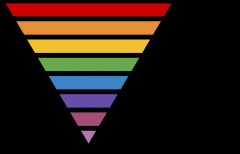
The system for which scientists use to organize organisms (to their expected natural relationships). |
|
|
Five ways to classify organisms? ( Hint: Every Bug Hates Eagles) |
1. Evolutionary relationships 2. Biochemical relationships 3. Homologous relationships 4. Embryological relationships |
|
|
Evolutionary relationships |
Describes the relationship between an ancestral species and their descendants and how they have varied over the years. Evolutionary trees can be used to show this relationship. |
|
|
Evolutionary relationships example #1 |
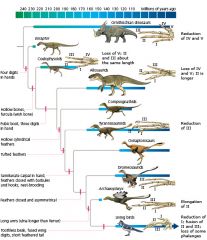
This evolutionary tree shows the relationships between dinasours (the ancestors) and modern day birds ( the descendants). |
|
|
Evolutionary relationships example #2 |

Vestigial- a structure of an organism that is smaller in size (compared to organisms of the same species that lived years ago), due to the fact that it's function is either needed less or no longer needed. An example of a vestigial would be hip bones on a whale. |
|
|
Biochemical relationships |
Looks at the various amounts, types and numbers of of chemical processes such as amino acids and structures such as DNA, RNA, proteins, and chromosomes between organisms. |
|
|
homologous relationships |
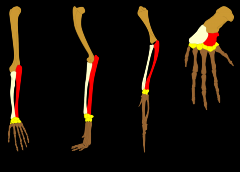
Compares diffrent organisms that are very different, but have body parts that developed from the same ancestral part. An example would be a human arm, a cat leg, a bird wing and a whale flipper. |
|
|
Embryological relationship |
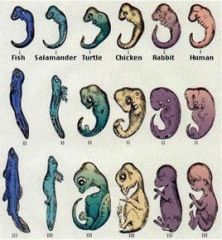
Compares embryos of diffrent organisms and their development, as well as how they looked very similar in the early stages of the embryos lives. All oranisms in an embryological relationship all have a common ancestral gene. An example would be the embryos of a fish, salamander, turtle, chicken, rabbit, and a human. |
|
|
Prokaryotic cell |
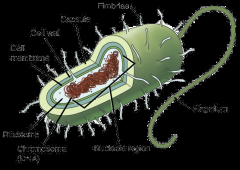
A cell that has no membrane-bound organelles such as a nucleus. All unicellular microorganisms are prokaryotic cells. |
|
|
Eukaryotic Cell |
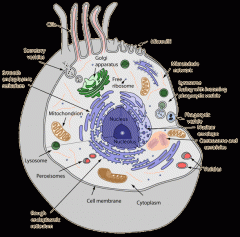
A cell that contains a nucleus surrounded by a membrane, as well as contains DNA that is bound together by proteins into chromosomes. Eukaryotic cells contain many organelles that are not present in prokaryotic cells, such as the mitochondria. |
|
|
5 types of kingdoms |
1. Monera 2. Protista 3.Fungi 4. Plantae 5. Animalia *The main criteria for a kingdom are cell structure, nutritional requirements, developmental patterns* |
|
|
Monera |
Contains prokaryotic cells (no cell membrane) that are autotrophic (produces their own food) and typically reproduce by asexual budding or fission. Example: all bacteria |
|
|
Protista |
Contains Eukrayotic cells (contain a cell membrane) that are autotrophic or heterotrophic and they generally reproduce by binary fission, some species can reproduce sexually. Example: euglena |
|
|
Fungi |
Contains eukaryotic cells that are multicellular organism that are also heterotrophic ( does not make their food) reproduce using spores. Example: mushrooms |
|
|
Plantae |
Contains Eukrayotic, multicellular organisms that are autotrophic and reproduce using seeds. Examples: Plants |
|
|
Animalia |
Contains Eukrayotic, multicellular organisms that are heterotrophic and reproduce sexually or asexually. Example: Animals, mammals |
|
|
7 levels of classification ( King Penguins Can Only Feed Gentle Snakes) |
1. Kingdom 2. phylum 3. class 4. order 5. family 6.genus 7. specie |
|
|
7 levels of classification example#1 |

kindom- Animalia phylum: Chordata Class: Mammalia Order: Perissodactyla Family: Equidae Genus: Equus specie- caballus binomial nomenclature: equus caballus equus- horse caballus- cactus common name: cactus horse |
|
|
7 levels of classification example #2 |
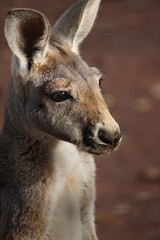
Kingdom: Animalia. Phylum: Chordata. Class: Mammalia. Order: Diprotodontia. Family: Macropodidae. Genus: Macropus. Species: rufus. Binomial nomenclature: Macropus rufus. Macropus- kangaroo Rufus- red common name: red kangaroo |

